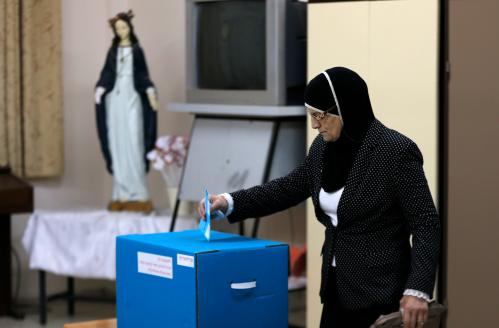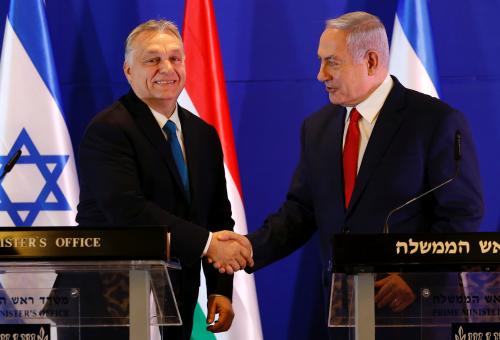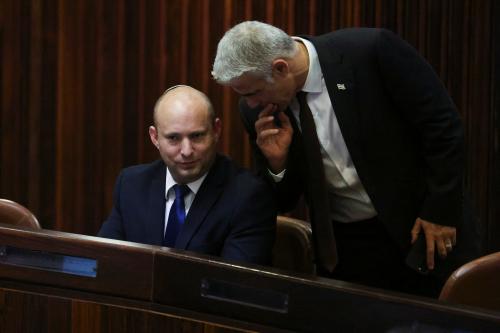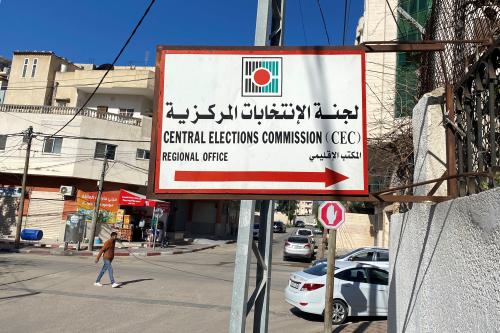Israelis head to the polls on Tuesday to elect the 120 members of the 21st Knesset. The results will provide just the first major stop in a tumultuous political year ahead. Polling averages—see below—suggest a tight race, but one in which incumbent Prime Minister Benjamin Netanyahu holds a consistent advantage over his main challenger, former chief of staff of the Israel Defense Forces Benny Gantz. The polls also suggest a great deal of uncertainty: Not only is the pro-Netanyahu advantage modest, but several small parties on both right and left have seen their vote totals hover around the electoral threshold for entrance into the Knesset. If they fail to clear 3.25 percent (nearly 4 seats), their votes would be discarded, potentially upending the equilibrium between the left- and right-wing blocs.
For Netanyahu, this election presents not only a battle for his political life, but possibly a battle for his personal freedom. The Israeli attorney general has decided to indict Netanyahu in three cases, including one charge of bribery, pending a hearing with the prime minister and his lawyers in July. Bibi’s lawyers face the challenge of undoing what months and years of investigations have presented to the attorney general (a Netanyahu appointee). Barring their unlikely success, Netanyahu will need a coalition willing to keep him in power through one of two unpopular avenues. First, he could maintain the support of such a coalition while on trial for serious crimes (he would only have to resign by law if convicted). Or, better yet for Netanyahu, he could form a coalition willing to pass legislation granting the prime minister immunity from prosecution. With all these uncertain factors at play, it is possible that we see another round of elections before too long—maybe even within the year.
Netanyahu’s challenger, Benny Gantz, is running for elected office for the first time. It will be his only chance to fully make use of his status as a recent chief of staff for the Israeli Defense Forces (IDF), a coveted role that conveys popularity and gravitas, before he is no longer considered untarnished by politics. In the next round, whenever it comes, he will still have his old military rank, but he will never again enjoy the status of a pure outsider.
How elections in Israel work
In February, each party or alliance of parties presented a rank-ordered list of Knesset candidates to the central election commission. For example, the Likud, Netanyahu’s party, listed him in the first place, followed by the rest of its candidates. While the Likud chooses its list largely by primary, in some parties the leadership nominates the whole list.
On April 9, Israel’s adult citizens will have the opportunity to cast a paper ballot indicating one of the competing lists. All Israelis vote in a single, nation-wide district. After the votes are tallied, the 120 Knesset seats are allocated to the lists in proportion to the vote total each receives, so long as they pass the minimum 3.25 percent threshold. A party that received a quarter of the votes, therefore, would receive 30 seats. This kind of proportional representation system tends to produce many parties, and Israel usually has about a dozen Knesset factions representing different niches of Israeli society.
Once the results are finalized, Israel’s president, Reuven Rivlin, who has a largely ceremonial role and is not up for election this year, will invite representatives of each list to his residence. There he will ask them to recommend one of the 120 members of Knesset (MKs) to form the next government. If a majority—61 or more—recommend one member, the president will task that person with the job of forming a majority coalition and presenting a new cabinet to the Knesset for a vote of confidence. (No party in Israel has ever received a majority on its own, and so coalitions are necessary.) Coalition negotiations will include the division of portfolios—defense, finance, foreign affairs, education, and others—and an agreement on the government policy guidelines.
If no candidate receives the recommendation of 61 MKs, the president’s task becomes harder. He must assess who has the best chance of forming a coalition and task him or her with the job. If that person fails, he may turn to another MK. In extremis, new elections could be called.
Israeli law prohibits the publication of polls in the last three days before an election. Above is an average of the last polls from the major news outlets. Parties that do not pass the minimum 3.25 percent vote threshold are listed at 0 seats, and the votes they did receive are reflected in the other parties’ totals. Most of these others see their seat totals rounded up, while the two largest receive an additional seat (Israel’s system of allocating excess votes slightly favors larger parties). The above approximations are highly sensitive to the exact distribution of votes each party receives, as those with five or six seats in this average are still in risk of falling below the 4-seat threshold. Conversely, some parties at zero in this chart are not far from qualifying, in particular Raam-Balad, whose base in the Arab population in Israel is not well polled, and Yisrael Beitenu, led by former Minister of Defense Avigdor Lieberman.
Three scenarios
1
Right-right Netanyahu coalition
If election results are similar to these polling averages, the opposition Blue and White party, led by Benny Gantz, would be the largest faction in the next Knesset. Netanyahu, however, would almost surely form the next government and return to the prime minister’s residence. A view of the party blocs shows why:
The pro-Netanyahu bloc—right wing, center-right, and ultra-Orthodox (Haredi) bloc— tallies 66 seats in this average, representing a clear majority for Netanyahu, who could then negotiate with his existing coalition partners (with the addition of a new entrant, Zehut) and form a right-wing coalition.
This may not, despite appearances, represent complete continuity. Netanyahu’s first priority would be to try and pass legislation granting him immunity. The price he would have to pay may be very steep—each of the potential coalition partners could potentially topple him, allowing them to demand a ransom for his freedom. The loot would be senior cabinet portfolios and policy. Netanyahu may even do what was unthinkable until recently: Move toward the annexation of parts of the West Bank.
2
Netanyahu-led national unity government
In normal times, Netanyahu would probably have preferred a different coalition: a “national unity” government that would include both the Likud and at least part of the Blue and White opposition list, together with ultra-Orthodox parties and some of the right wing. This would allow Netanyahu to govern from the center and allow him to avoid some of the more extreme policies of the far-right. A right-center coalition, as can be seen above, could easily command a majority, even if parts of Blue and White refuse to join. And such a coalition could also appeal to the leaders in Blue and White—Gantz and former finance minister (under Netanyahu), Yair Lapid—who may want to approach the next election, and perhaps the post-Netanyahu era, as a senior cabinet ministers rather than election losers.
Indeed, if Netanyahu sees that his right-wing coalition partners are not willing to grant him legal immunity, he may then bolt to the center and explore—or appear to explore—joining with the opposition, at least so as to lower the ransom price of the far-right.
The excuse is ready-made: the Trump peace plan, perennially about-to-be-released. If the plan is released before the coalition in Israel is formed, as Tal Shalev of Walla! reported it will be, Bibi and Gantz could both set aside their vows never to accept the other’s leadership. Instead, facing a major diplomatic challenge/opportunity, they could profess to answer the call for national responsibility. It would seem cynical to voters—very, very few of whom expect anything to come of the peace plan—but it could provide the political cover they would need to form a unity government.
Such a coalition would be far more moderate than a right-right coalition. It would not shift away dramatically from existing policy on most issues, but it could moderate a lot of the policies of the past three years. It would also likely be short-lived, lasting only until Netanyahu is indicted and his new partners bolt.
3
A Gantz coalition
A “preventive bloc” of 60 MKs could emerge if the polls are off—and not by that much—or if, in a slightly more likely scenario, a couple of parties on the right do not pass the electoral threshold while those on the left do. Should the center-left and Arab-based parties win enough seats to prevent Netanyahu’s formation of a coalition, the president would likely ask Gantz to try.
The task would be formidable. The Arab-based parties would not be welcome in the coalition, nor would they seek to join it. Even if one of those parties, Hadash-Ta’al, supported the government from the outside, Gantz would almost certainly need a majority without them. With Netanyahu blocked, some of his soft support may defect. Current Finance Minister Moshe Kahlon may prefer to bring Netanyahu down, given the right political cover. Avigdor Lieberman, if his party squeezed in, might do the same. The ultra-Orthodox (Haredi) parties, or elements from among them, might consider joining a Gantz government for the right concessions, despite their aversion to Gantz’s partner Yair Lapid. Even the curiosity of this campaign, the libertarian right-wing Zehut party, might decide to put a pause on its leader’s extreme ideological positions on the West Bank for other policy achievements. Or, none of them may join, and Gantz may return to the president with no coalition.
If Gantz were to succeed, his government would feature a great deal of continuity on policy toward Syria, Lebanon, Gaza, and most diplomatic efforts. Gantz and his three partners, after all, served under Netanyahu. On Iran policy, there may be some shift in tone and nuance, but almost no one in Israel is actually dovish on Iran.
In two areas, a Gantz victory would mean real change. It would mean small but meaningful change on the Palestinian front. Gantz would not likely pursue grandiose moves early, but the long-term vision of most of the Blue and White leaders (minus Moshe Yaalon, a right-wing, anti-Bibi former defense minister) is very different from Netanyahu’s and the right wing. Far from looking for annexation, they hope for separation from the Palestinians, and might manage the conflict very differently in lieu of a final status deal.
And on domestic affairs there may be a sea change on issues such as respect for judicial oversight, relations of the executive to the press, attention to corruption, and relations—at least rhetorically—between the Jewish majority in Israel and the 20 percent of Israelis who are Arab. In this, more than anything, the difference between Netanyahu and most other alternatives is stark.
This week, Gantz is that alternative. It may well be someone else in the future: another leader from Blue and White such as Gabi Ashkenazi, or, most likely, another leader from Netanyahu’s own Likud.






Commentary
Israeli elections primer: Final polls and what they mean
April 8, 2019